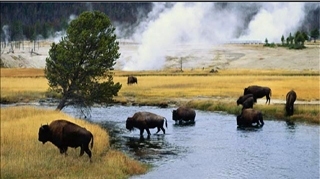|
Watson Barn
Background about the Ranch and why
the Barn was Built –
The ranch was commonly described as extending from Kearney to Odessa, from
the Platte River to the hills north of what is now Highway 30.
The headquarters for the ranch was 5 miles west of downtown Kearney.
Highway 30 goes through the middle of where the buildings used to be.
The original part of the ranch house was build at David Anderson’s home.
He sold his land to Watson.
There were maybe 15 small houses where the married employees and their
families lived. The single men bunked upstairs in the ranch house.
There was also a schoolhouse.
Alfalfa grew under drought conditions
1893 – raised 15 acres of alfalfa, increased to 3000 acres
1896 – 3000 tons of alfalfa but could not sell it.
1897 – sold 1000 tons to sheep feeder for $3/ton & gave him all the old hay
in the stacks.
Like so many things Watson did – big but inefficient and, therefore, not
financially successful.
Could not harvest alfalfa efficiently
because of lack of equipment and men.
Watson started feeding sheep, cattle, and work horses to show how good the
hay was.
Established dairy operation. Brought in a carload of Holsteins from Iowa
State Ag. College to form basis of herd.
Construction –
Completed in 1900
Barn was designed by Professor Oscar Erf, Ohio State
Was to be a 1200 cow unit.
Watson wanted to build the whole thing but Prof. Erf persuaded him not to.
So 1/3 was built.
Some lumber purchased from Emil Tollefsen, employee at Gilcrest Lumber
Most shipped from west coast
Carload of hardware from Denver
Descriptions and Use
–
Sometimes Conflicting
Usually described as being 300’ long, 100’ wide, 56’ at highest peak
Publicized as the largest barn in the world
Teams could enter the second floor from the east or west at the north end.
900 tons of hay could be stored
First floor – 200-300 stalls; 400 stalls.
Some accounts said there was also
room for calves plus the horses needed
Feed and refuse handled by trolley
Second floor – for farm equipment storage
For hay storage
Sheep
Third floor – for hay storage
Silo at rear, built into side of hill
Sides bricked up
[pictures show a rectangular frame building behind the barn and its T at
north end]
Could hold silage from 160 acres of corn
Tromped down by mules.
(footnote by Phil Holmgren in typed version says cow herd was augmented by
taking cows on consignment. When payments were smaller than expected or
skipped, the owner could get the cows back and be glad they did not get a
feed bill.)
Cream and milk went to the UP dining cars.
1903, spring – Creamery burned; not rebuilt
“Watson’s method of financing has been described as taking from Peter to pay
Paul but never giving Paul as much as was taken from Peter.” – Result was
bankruptcy, lost the ranch in 1906.
From article in Country Life in America, Jan. 1907, by Gene
Stratton-Porter
(Based on information provided by H D Watson after he had lost the ranch but
he gave her a tour of the place pretending it was still his.)
“Mr. Watson built the world’s largest dairy barn, 317 feet in length and 96
feet wide, with every modern convenience, stone floors, room for 350 cows,
each in her own separate stall, and set all his followers to feeding their
alfalfa to cows, and shipping butter, cream and cheese to the great
markets.”
Tearing it Down –
Torn down in 1935
(“Huge 1733 Ranch Barn, Known Over Nation, Being Torn Down,” Kearney
Daily Hub, March 18, 1935, page 3.)
Crumbling foundations, no longer considered safe.
William Wright, owner of 580 acres of original ranch, mostly north of
Kearney Canal.
Most of lumber considered worthless
Some salvaged and sold.
(McCook Daily Gazette, June 22, 1959 interview with man who had been
foreman in early 1920’s”)
He said, “after they finally got the big thing down, there was lumber
stacked shoulder high in every direction.”
(July 13, 1993 Hub)
Reported the 4000 square feet remainder of the barn was blown down.
The property was owned by Dean Beavers.
Location of Barn
–
Definitely on north side of Highway 30, north of Kearney Canal.
Frank & Watson in Kearney Boom
Frank came in 1886 – Kearney Canal
Watson came in 1888 – Bought half of Frank investments
[Both wheeler dealers]
Boom ended in 1892
Watson split with Frank
Sources
Donna Richards collection in Archive files of
all information she could find and copy
Hub photos in the Archives
Where the Buffalo Roamed
Buffalo Tales October& November, 1979, Phil Holmgren – Two part article about H D Watson &
the ranch
“Huge 1733 Ranch Barn, Known Over Nation, Being Torn Down,” Kearney Daily
Hub, March 18, 1935, page 3.
|

